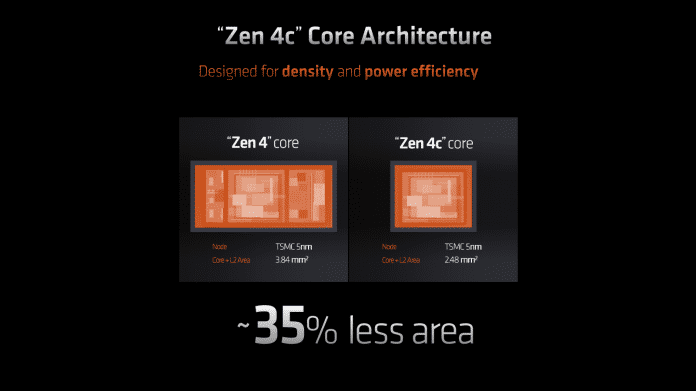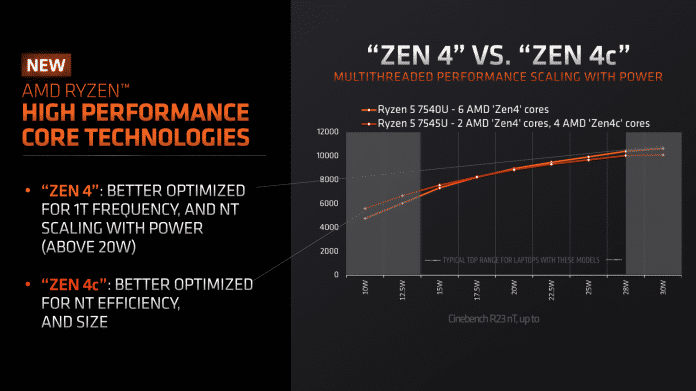It’s one of the strangest ideas of recent years: AMD now officially recognizes the existence of its “Phoenix2” processor chip – months after such models first appeared, including in the cheaper version of Asus’ ROG Ally handheld PC.
Advertisement
Phoenix2 is AMD’s first die that combines the two different core types Zen 4 and Zen 4c. As with all previous Ryzen processors, the former is designed for the highest possible clock frequencies. AMD originally designed the Zen 4c cores for the Bergamo cloud processor: They have the same range of functions, but are significantly more compact. This means that AMD can fit more CPU cores into the same chip area.
To reduce the area, AMD relies on a more relaxed clock curve. Zen 4c cores have lower clock speeds and can therefore be designed more compactly, i.e. with fewer filling transistors. The caches also use more compact SRAM cells. A block consisting of the CPU core and level 1 and level 2 caches measures 2.48 instead of 3.84 mm² – around 35 percent less. A level 3 cache halved per core brings further savings.

Size comparison: Zen 4c cores are around 35 percent more compact than their Zen 4 counterparts. AMD saves additional space with the Level 3 cache.
(Image: AMD)
Meanwhile, Phoenix2 is designed for inexpensive notebooks. In addition to saving space on the CPU cores, AMD divided the integrated Radeon GPU from 12 to 4 compute units, i.e. from 768 to 256 shaders. A Phoenix2 chip measures 137 mm² – Phoenix(1) measures 178 mm². The chip contract manufacturer TSMC produces both variants using 5-nanometer technology.
Ryzen 5 7545U and Ryzen 3 7440U with Zen 4c
However, the Zen 4c design also has an efficiency advantage when electrical power budgets are tight, making them also suitable for compact notebooks. According to AMD, Zen 4c cores achieve higher clock frequencies with power limits of less than 15 watts. An earlier test showed the limit at around 2 GHz, above which normal Zen 4 cores work more efficiently.

The Zen 4c cores require less electrical energy than Zen 4 cores at low clock frequencies.
(Image: AMD)
It was previously assumed that AMD wanted to use the Phoenix2 die hidden in the Ryzen 5 7540U and Ryzen 3 7440U notebook CPUs as an alternative variant to Phoenix(1). Our test results for the HP notebook EliteBook 845 G10 with Ryzen 5 7540U also matched this. Our sample was a Phoenix(1), but it behaved like a Phoenix2: Only two CPU cores managed the maximum boost of 4.9 GHz, the four others only achieved a maximum of 3.5 GHz. Other Zen 4 models such as the Ryzen 7 7840U apply the advertised maximum boost to all cores.
Now AMD has clarified things: The Ryzen 5 7545U gets Phoenix2 with two Zen 4 and four Zen 4c cores and replaces the previous Ryzen 5 7540U. In the case of the Ryzen 3 7440U, the previously announced Zen 4 version is said to have never reached the market. The new Ryzen 3 7440U now only has one Zen 4 core, paired with three Zen 4c.
This makes the already confusing processor naming scheme even more confusing. AMD now sells six different chip variants with different CPU and GPU versions within the Ryzen 7000 series. Renaming the Ryzen 3 7440U to 7445U would have been at least slightly more consistent.

The Ryzen 5 7545U and Ryzen 3 7440U bring Zen 4c cores to notebooks.
(Image: AMD)
Regarding the current announcement, AMD has now confirmed that operating system schedulers do not require any adjustments in order to distribute programs sensibly across the cores. The Windows scheduler, for example, already recognizes the fastest CPU cores and gives them the most computationally intensive tasks.
Intel has been pursuing a different approach with its processors since the Alder Lake generation (Core i-12000): The performance and efficiency cores also differ based on the range of functions – the E-Cores do not support all the instructions of the P-Cores. A built-in thread director distributes the computing tasks.
(mma)

